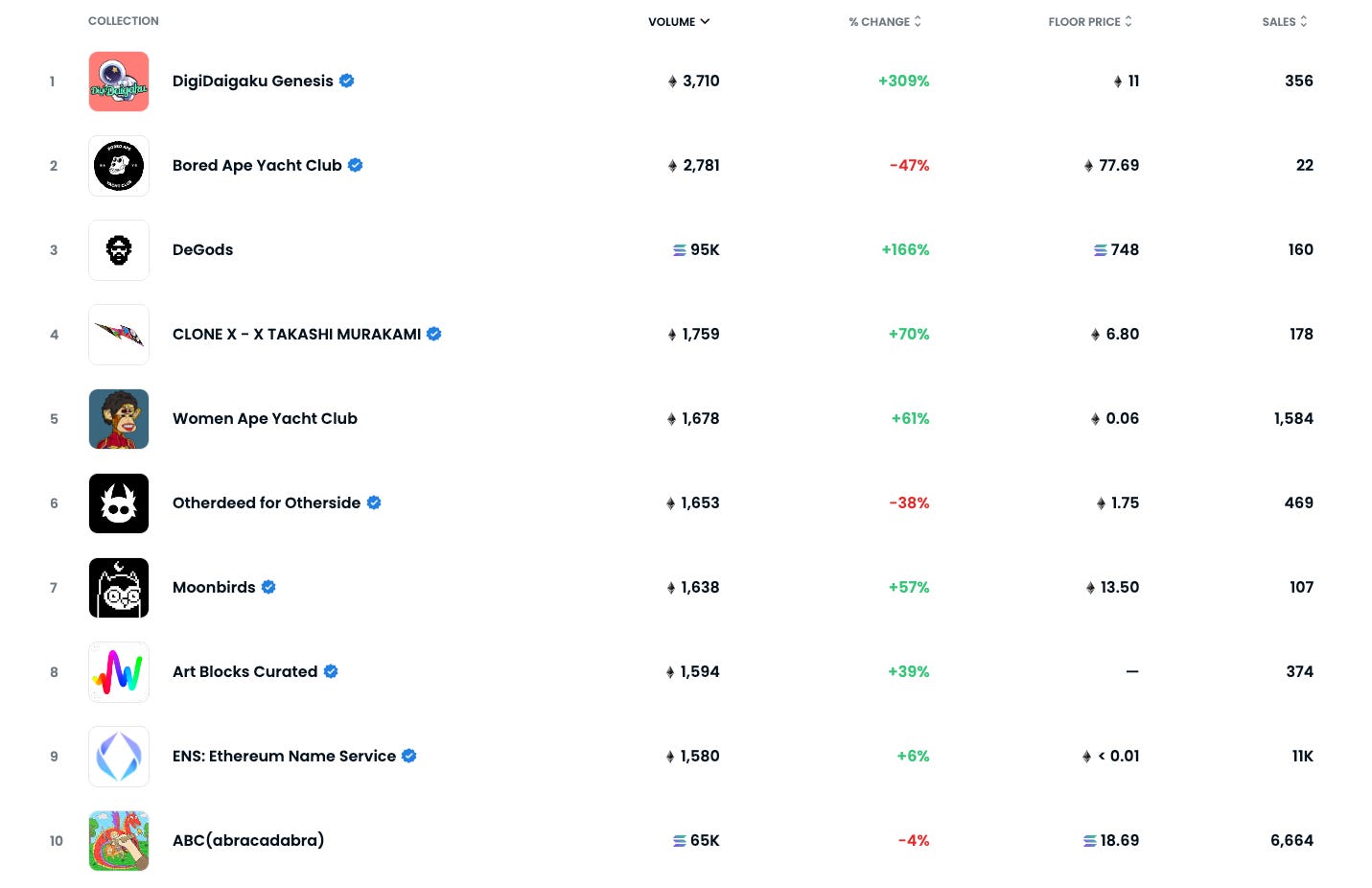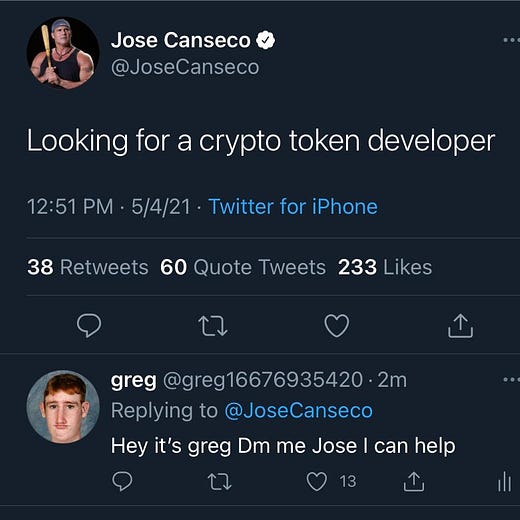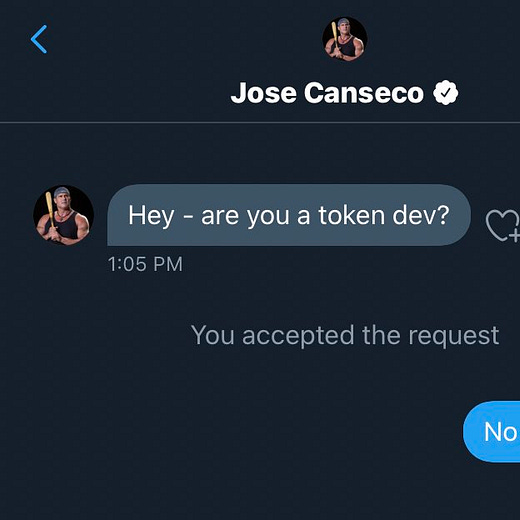No sausage jokes, DeGod dominance, and shoes that'll never touch grass (Issue #37)
It doesn't matter how big it is, anon, it's what he does with it.
We’d like to give a special shoutout to Goats and the Metaverse this week, the YouTube show on all things NFT, hosted by Metaversal CEO and co-founder Yossi Hasson and collectibles expert Stanley Meytin. This week they had three, back-to-back, totally unmissable interviews with Farokh, Seth Green, and gmoney. Check those out towards the end of this week’s newsletter.
If you’re new to The Metaversalist and arrived here via a link or an email someone shared with you, please consider subscribing:
Right, let’s get straight into it!
Drop alert 🚨
Naturally, the key drop we’re watching this week is y00ts, but we’re also excited about news today out of Nifty Gateway. Today the marketplace introduced “Publishers,” a fresh take on its longstanding model of “Curated Drops” that introduces 50 new publishers/curators to the platform.
DYOR 🔬
Usually, in this portion of the newsletter, we look at the week’s single biggest story. But this week, we’re taking a gander at two of them, because they’re both things you should know about.
Gods among degens 🤌
The first concerns the phenomenal success DeGods has enjoyed of late. Despite running into some problems with its Twitter account (now resolved), DeGods has had a phenomenal run. It’s not only topped the charts in terms of floor price and volume for projects on the Solana blockchain… it has also consistently ranked in the top five for projects on all chains.
Why do we think this matters? Because in an open metaverse, the blockchain a project is on won’t matter. In fact, people might not even know which blockchain underpins their profile picture… or virtual T-shirt… or avatar. And that’s a good thing. It’s the kind of friction that keeps normies at bay, and that needs to be overcome for true mass adoption.
DeGods is a high-caliber project from an innovative team, and it would’ve succeeded on any platform. Ethereum may garner the most attention and the largest market cap, but that position isn’t inevitable. A great project is a great project, and if you make it great enough, you can overcome any obstacles. We’ve been saying this for a while…
Let’s get phygital 👟
When NFT studio RTFKT was acquired by Nike last December, it was an irrefutable sign that the bigwigs were paying attention to the NFT market. RTFKT has continued to innovate, and though it hasn’t always been smooth sailing (ahem, the winged virtual hoodie drop debacle), the partnership continues to push boundaries.
This week the duo announced Clone X holders will be able to claim limited edition Air Force 1 sneakers (well, claim and pay for). Which sneakers in the series they can claim depends on their NFT’s characteristics. The collection includes AF1s designed by Takashi Murakami, which look likely to be the most coveted of the drop.
As any user of Nike’s Sneakers app will tell you, getting hold of its exclusive drops is hard. Tethering them to an NFT collection in some ways makes them more accessible… if you’re holding the right NFT, that is. Which, in turn, is a massive incentive for sneakerheads to ensure they are holding the right NFT, giving NFTs precisely the same sort of exclusivity and desirability as rare sneakers.
With industry pioneer gmoney soon to drop his first capsule from his 9dcc luxury brand, it’s clear “phygital fashion” — that is, fashion with both digital and physical elements — is a category to watch, whether you’re a flipper looking to turn $1 into $2 (or $10 or $100), a style maven aiming to outflex the flexers, or a collector of sartorial icons seeking to create the sort of inheritance your kids will stop speaking to one another over.
🗡 Sounds a whole lot like something 🔎
Probably nothing 🤔
a16z updates CC0 🏛
Investment firm Andreessen Horowitz’s blockchain-focused arm, a16z Crypto, has harnessed the powers of its legal team to create licenses for NFTs in order to remove ambiguity, protect rights holders, and empower owners. Called the “Can’t be Evil” NFT licenses, they can be added to a project’s smart contracts with a few lines of code.
There are six “CBE” licenses, and the name is an allusion to Google’s original mantra of “Don’t be Evil,” but with the added trustlessness component inherent in web3’s core tenets. All six have been deployed on Arweave and are available from GitHub so that they’re as easy to integrate into projects as possible.
The marketplace of ideas 🛍
Tezos-based generative art platform fx(hash) launched fx(text) last week, a new service that lets users create blog posts, tokenize them, and (eventually) sell them like they would an NFT. Except, posts aren’t conventional non-fungible tokens, they’re semi-fungible tokens. Why? Editability.
While NFTs are usually designed to be immutable by default, we believe this paradigm shouldn't apply to fx(text) articles. The pace at which our world changes makes immutable articles, i.e., unchangeable articles, the equivalent of creating time capsules, whereas we’re interested in creating living documents. As such, fx(text) articles can be edited and updated at any time, including after minting.
Edits will be tracked on the blockchain, and publishers can choose to permanently lock token metadata should they wish to. Which we hope many will do once they’ve ironed out any typos, because immutability does feel like a key ingredient of blockchain solutions.
Speaking of edits ✍️
The unofficial home of NFT discourse, Twitter, has announced it’s finally introducing an edit button… a feature its users have been pleading for since the service’s inception in 2006. Twitter says its employees will get to test the service first, after which it’ll be rolled out to users of its $3-a-month Twitter Blue service, before eventually being offered to all and sundry.
Users will have 30 minutes to edit a Tweet after posting it, and edited tweets will be marked with a label that, when clicked on, shows the history of edits. You know… like Facebook’s edit function… which was introduced in June… of 2012. 👀
Bag boosters 💸
The week that was (Aug 25 - Sept 1, 2022) 🗓
We’ve already covered DeGods and RTFKT/Clone X’s killer weeks, so the real news here is DidiDaigaku Genesis and its wild 11 ETH (~$17,400) floor price. You’d be forgiven for responding, “Eh?” So here’s the lowdown: Limit Break is a new blockchain game from free-to-play gaming pioneer Gabe Leydon. For the full rundown on his background and how he hopes to make “free-to-own” NFT games big business, check out this deep dive into his past and his ambitions for the future.
📚 Available in, err, hardcover? 📓
NGMI ☄️
Phat rhymes, flat graphics 👾
Last weekend, notable Bored Ape Yacht Club members and superstar rappers, Snoop Dogg and Eminem, “performed” at the MTV Video Music Awards (VMAs). While it’s hard to deny the artfulness of the bars that were spat, it’s pretty easy to quibble with the quality of the accompanying graphics.
The duo may be legendary, the lyrics may be memorable — and the indication that this NFT stuff might have some legs is pretty hard to miss — but the circa-2005-CGI visuals are a reminder of just how early it is, frens.
To the moon 🌛
Proof Collective announced a $50 million Series A raise led by a16z Crypto… along with a new PFP collection called Moonbirds Mythics. It’ll consist of 20,000 PFPs and is set to arrive early next year.
World of Women announced the Capacitor NFTs it airdropped to holders can be redeemed for a customizable virtual apartment created by virtual gallery service OnCyber and designed by the project co-founder, Yam Karkai.
The International Council of Museums (ICOM) updated its definition of “museum” to include words like “diversity,” “sustainability,” “accessible,” and “inclusive,” all of which are things web3 and digital museums can arguably provide.
NFT marketplace OpenSea has made its position clear when it comes to how it’ll treat proof-of-work NFTs after the Ethereum blockchain moves to proof-of-stake later this month with The Merge. In a short thread on Twitter, OpenSea says it won’t support or display proof-of-work NFTs once The Merge happens.
Ticketmaster is going to use the Flow blockchain to enable event organizers to tie NFTs to tickets. They can be used as digital merch, for loyalty programs, or for giveaways and other promotions.
Coinbase user Brant Boersma paid 119.2 ETH (~$185,000) for a Bill Murray NFT that includes the chance to lift the elbow with the actor while someone paints a picture of the event.
Twitter temporarily suspended and then reinstated various DeGods and y00ts-related Twitter.
Digital avatars company Genies unveiled “The Warehouse,” an NFT storefront for selling digital fashion items. Item creators retain their IP and get a cut of every sale, while Genies takes a 5% fee.
Oh, and in an unmistakable signal that the old world is embracing the new, Warner Records U.K. has teased a new record label called “Probably a Label.”
🪡 Thread of the week 🧵
Goats only 🐐
Whether you like your licenses creative and common or (ad)venturous and capital(ized), you should be watching or listening to Goats and the Metaverse.
In each episode, collectibles OG and entrepreneur Stan “The Goat” Meytin and Metaversal co-founder and CEO Yossi Hasson talk about digital and IRL collectibles, NFTs, and the week’s news worth knowing. They also bring on incredible guests to talk about the sector and share their wisdom.
This week, they sit down with NFT entrepreneur and Rug Radio host Farokh to talk about community building in web3. Talk to actor Seth Green about his NFT TV show, and get the lowdown from gmoney about his luxury 9dcc brand. Check out the latest episode here:
Aside from providing invaluable insights into digital art and collectibles, Stan and Yossi are also putting together a collection of NFTs dubbed “The Goat Vault.” When the show hits 5,000 subscribers on YouTube, one of those lucky subscribers will win the contents of the vault which, at last count, was valued at over $18,000.
Prefer listening? Check out Goats and the Metaverse on Apple Podcasts, Spotify, Anchor, or wherever you get your podcasts.
LFG 🎉
Money <> mouth 💸
Each week we offer you a look at an NFT project we’ve invested in and the motivation behind it. This week we’re looking at “Chromie Squiggle #7273” by Snowfro.
We’ve been bullish on Squiggles for a long time, so adding a rare one (a Hyper Rainbow, a trait only present in ~1% of the collection) was, as they say in the industry, something of a no-brainer. Check out the thread above for more information on our thinking behind the acquisition.
IYKYK 😉
Until next time, see you in the Metaverse.












